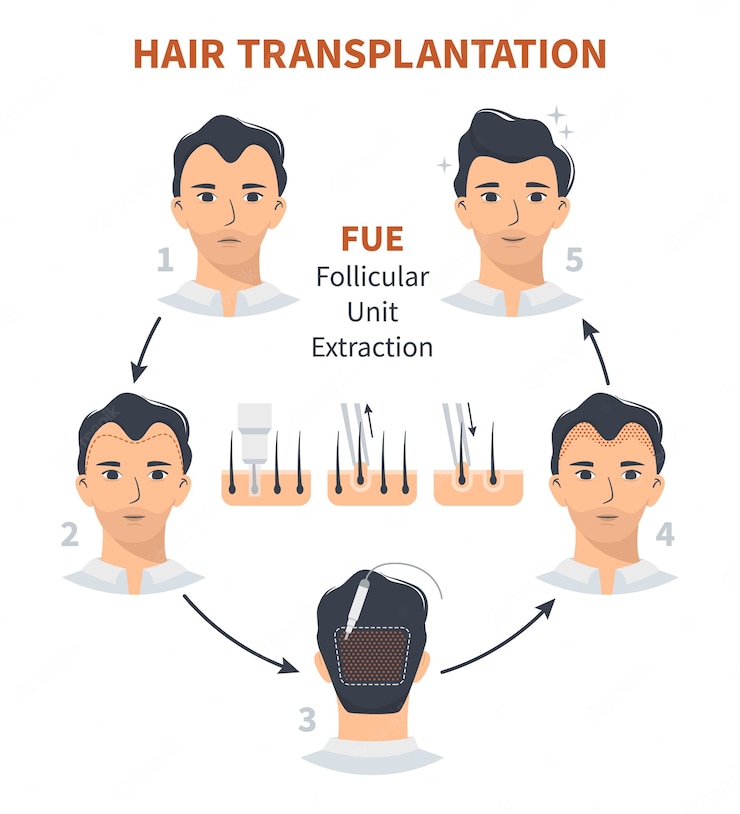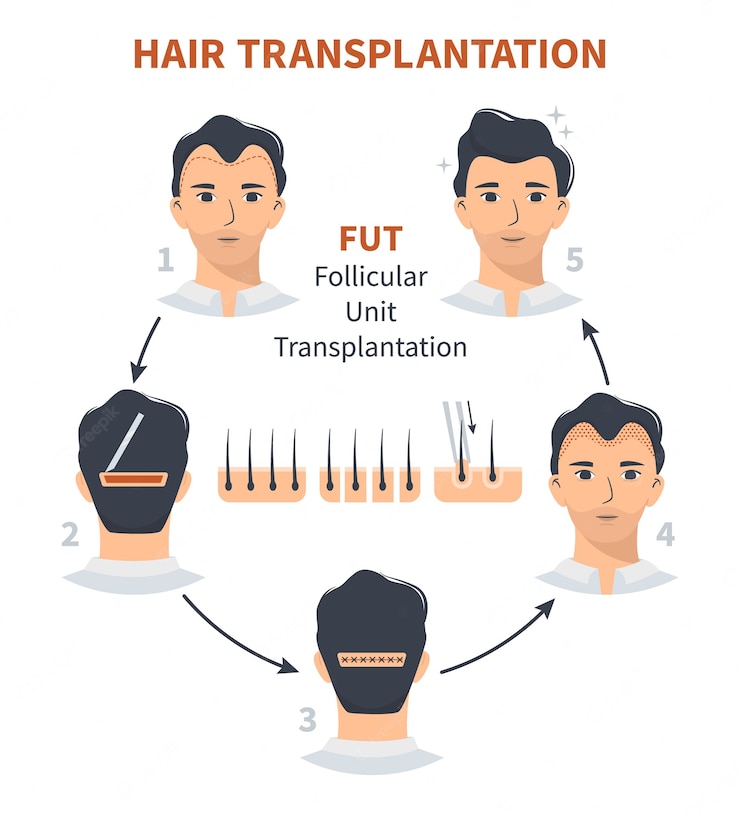Extent Hair Transplant and Skin Care restores hair and skin. Our skilled staff knows how hair loss and skin diseases affect mental health. Extent Hair Transplant and Skin Care in Islamabad ensures your comfort during the treatment. We use the latest hair transplant and skincare technology to treat you.
FUE & FUT Hair Transplant
FUE Hair Transplant at Extent Hair and Skin Clinic
Unleash Your Natural Hair Growth Potential
Modern Follicular Unit Extraction (FUE) hair transplant techniques are available at Extent Hair and Skin Clinic to help you regain your confidence and achieve natural-looking hair growth. To ensure that our patients receive the best outcomes possible, our skilled team of hair restoration professionals uses cutting-edge methods and equipment.
What is FUE Hair Transplant?
Follicular Unit Extraction (FUE) is a minimally invasive hair transplant technique that involves extracting individual hair follicles from a donor area and implanting them into the recipient area, where hair growth is desired. Unlike traditional hair transplant methods, FUE does not require a linear incision or the removal of a strip of scalp tissue, resulting in less scarring and a faster recovery time.


Schedule a Consultation Today
Schedule an appointment with our skilled hair restoration team at Extent Hair and Skin Clinic if you’re ready to take the first step toward getting more hair and feeling better about yourself. During your consultation, we’ll figure out what your specific needs are and talk in depth about the FUE hair transplant process.


FUT Hair Transplant at Extent Hair and Skin Clinic
Restoring Hair with Precision and Expertise
At Extent Hair and Skin Clinic, we use advanced Follicular Unit Transplantation (FUT) hair transplant techniques to help you restore your hair in a way that looks normal and lasts for a long time. Our skilled team of hair transplant doctors uses the most up-to-date methods and tools to give our patients great results.
What is FUT Hair Transplant?
Follicular Unit Transplantation (FUT) is a tried-and-true method for restoring hair. During FUT, a strip of hair-bearing tissue is taken from the donor area, which is usually the back or sides of the head. The donor strip is then carefully cut up under a microscope into small pieces called follicular units. These are then transferred into the part of the body where hair growth is wanted. FUT is well-known for being able to restore a high quantity of hair.
Your Questions, Answered!
Frequently Asked Questions (FAQs)
Answer: FUE (Follicular Unit Extraction) removes individual hair follicles from the source area, while FUT (Follicular Unit Transplantation) removes a strip of hair-bearing tissue to remove follicular units. FUE leaves small scars that look like dots, while FUT leaves a long scar that can be hidden by the hair around it.
Answer: The decision between FUE and FUT relies on many things, such as the amount of hair loss, the amount of donor hair available, and the patient’s own preferences. FUE is best for people who want less scarring and a faster recovery time, while FUT is best for people who need more grafts or don’t have enough donor hair.
Answer: Hair transplant surgeries, both FUE and FUT, are performed under local anesthesia, ensuring that you experience minimal discomfort during the procedure. Some patients may experience mild soreness or discomfort in the days following the surgery, which can be managed with prescribed medications.
Answer: Yes, the grafted hair follicles are usually permanent. This is true for both FUE and FUT. The hormone that causes hair loss, dihydrotestosterone (DHT), doesn’t affect these cells. But it’s important to remember that hair that hasn’t been transferred may continue to fall out on its own over time.
Answer: After a hair transplant, it takes time for the new hair cells to take hold and start growing. Most of the time, you can see growth after three to four months, and big changes happen between six and twelve months. The end effect can be different for each person and may take a year or more.
Answer: Yes, hair transplants can also work for women whose hair is thinned or falling out. But the reason for hair loss and the health of the source area should be carefully looked at. If a woman has a disease like diffuse hair loss or not enough donor hair, she may need extra care and a customized treatment plan.
Your Questions, Answered!
Frequently Asked Questions (FAQs)
Answer: FUE (Follicular Unit Extraction) removes individual hair follicles from the source area, while FUT (Follicular Unit Transplantation) removes a strip of hair-bearing tissue to remove follicular units. FUE leaves small scars that look like dots, while FUT leaves a long scar that can be hidden by the hair around it.
Answer: The decision between FUE and FUT relies on many things, such as the amount of hair loss, the amount of donor hair available, and the patient’s own preferences. FUE is best for people who want less scarring and a faster recovery time, while FUT is best for people who need more grafts or don’t have enough donor hair.
Answer: Hair transplant surgeries, both FUE and FUT, are performed under local anesthesia, ensuring that you experience minimal discomfort during the procedure. Some patients may experience mild soreness or discomfort in the days following the surgery, which can be managed with prescribed medications.
Answer: Yes, the grafted hair follicles are usually permanent. This is true for both FUE and FUT. The hormone that causes hair loss, dihydrotestosterone (DHT), doesn’t affect these cells. But it’s important to remember that hair that hasn’t been transferred may continue to fall out on its own over time.
Answer: After a hair transplant, it takes time for the new hair cells to take hold and start growing. Most of the time, you can see growth after three to four months, and big changes happen between six and twelve months. The end effect can be different for each person and may take a year or more.
Answer: Yes, hair transplants can also work for women whose hair is thinned or falling out. But the reason for hair loss and the health of the source area should be carefully looked at. If a woman has a disease like diffuse hair loss or not enough donor hair, she may need extra care and a customized treatment plan.

